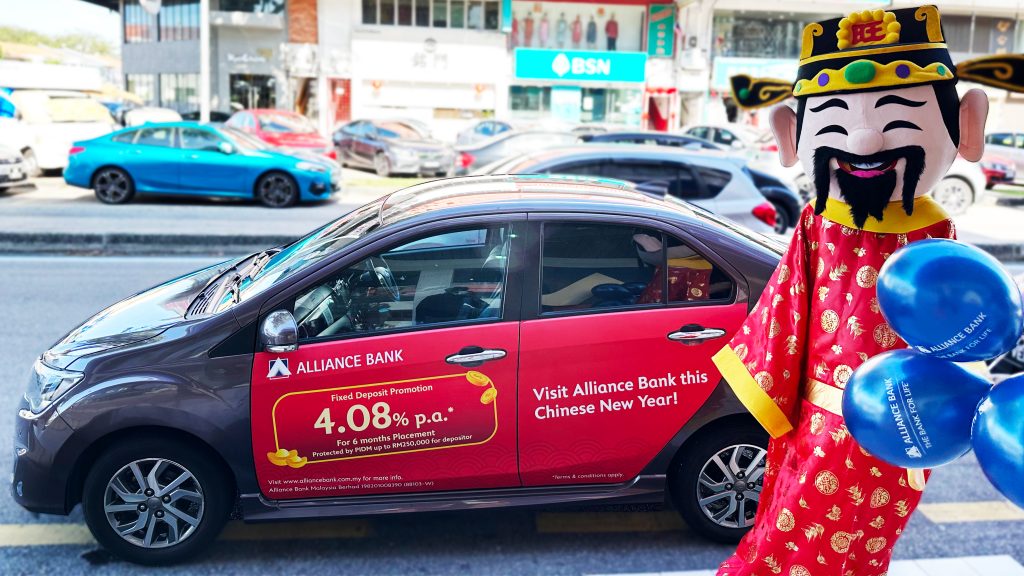By The Malketeer
Digital Overload: The 74% Problem No One’s Talking About
In a marketing landscape dominated by digital saturation, one Malaysian company is bringing brands back to the streets—literally.
VOOH Media, a vehicle out-of-home advertising network, has quietly been proving that what’s old is new again, with car advertising emerging as a powerful complement to digital strategies.
“Digital channels now account for over 74% of total ad expenditure—a trend set to continue into 2025—but this heavy focus can be counterproductive,” explains Rajiv Rai Singh, Co-Founder of VOOH Media.
Having previously led marketing at Lalamove Malaysia and Singapore, Rajiv witnessed first hand how an over-reliance on digital advertising creates diminishing returns.
“By focusing too much on digital, brands risk overlooking a critical fact: people still spend a significant amount of time in the physical world,” Rajiv reiterates.
This digital saturation has created the perfect environment for alternative advertising formats to thrive, particularly mobile out-of-home (OOH) solutions.
The Science of Motion: Why Your Brain Can’t Ignore Moving Ads
What makes vehicle advertising particularly effective isn’t just creative—it’s biological.
Research from MIT and the Salk Institute reveals that our brains are fundamentally wired to pay attention to objects in motion—an evolutionary survival mechanism particularly important for road users.
“Given that failing to notice moving objects can lead to accidents, consumers are naturally inclined to observe moving vehicles,” Rajiv explains.
“This built-in attentiveness means that ads on vehicles are almost guaranteed to be seen, whereas other OOH formats often require extra creative efforts to capture attention.”
This natural attention-grabbing quality combines with impressive reach metrics.
The average e-hailing vehicle carrying an ad travels between 4,000 to 6,000 km per month, with top performers reaching around 10,000 km.
VOOH Media’s campaigns consistently deliver at least 40% more kilometers of exposure than anticipated.

The O2O Effect: From Road Sightings to Google Searches
Perhaps the most compelling evidence of vehicle OOH’s effectiveness comes from VOOH Media’s ongoing effectiveness study.
Using Google’s brand search trend as their key metric, the company has documented remarkable results.
“Our latest research shows that 5 out of 6 brands experienced more than 40% increase in their brand search trend scores where vehicle-based ads were included in their campaigns,” Rajiv reveals.
“Conversely, when these car wrap ads were removed, we observed a noticeable decline in search trends.”
This offline-to-online (O2O) effect isn’t accidental.
According to research by the Outdoor Advertising Association of America (OAAA), 51% of consumers search online after encountering an OOH ad—turning physical impressions into digital engagement.
From Niche to Mainstream: Malaysia’s Growing VOOH Adoption
What began with early adopters like Grab, Lalamove, and Wonda Coffee has expanded to include established brands such as Asics, McDonald’s, Baskin Robbins, and KFC.
This shift signals growing recognition of vehicle OOH’s potential to extend brand presence in the real world.
“Malaysia’s OOH advertising landscape is at a pivotal stage,” notes Rajiv.
While the pace of adoption may be more measured compared to North America and Europe, the trend is clearly toward a more dynamic OOH ecosystem.
For Rajiv, the evidence was undeniable during his time at Lalamove.
“We monitored consumer search trends, and the data was compelling: as we increased our sticker deployments, more consumers began searching for Lalamove compared to our competitors. This surge in brand familiarity turned an otherwise unknown name into a household one.”

The Budget-Friendly Alternative to Traditional OOH
In the current economic climate, with advertising budgets under pressure, VOOH Media’s approach offers a compelling value proposition.
“Vehicle-based advertising offers a unique blend of advantages that traditional OOH simply can’t match,” Rajiv asserts.
“It’s remarkably cost effective—enabling brands to roll out statewide or nationwide campaigns at a fraction of the cost of traditional OOH.”
Unlike fixed billboards, vehicles traverse major highways, city centres, and even last-mile locations in gated residential and commercial areas.
This mobility diversifies exposure and helps prevent ad fatigue by ensuring messages reach audiences across various settings.
Beyond Advertising: The Social Impact of Vehicle OOH
VOOH Media’s business model extends beyond marketing effectiveness to create social impact.
By partnering with e-hailing drivers, many from Malaysia’s B40 and M40 income groups, the company provides additional income streams that help offset vehicle maintenance costs.
“Our vision at VOOH Media is closely aligned with the United Nations’ 8th Sustainable Development Goal—promoting decent work and economic growth for all,” explains Rajiv.
This alignment means that brands working with VOOH Media are not just improving their marketing performance but also contributing to economic wealth distribution.
Environmental concerns are increasingly important for brands, and vehicle OOH offers advantages here too.
“Mobile OOH offers notable environmental advantages compared to traditional formats,” Rajiv points out.
“Vehicle-based advertising leverages vehicles that are already on the road, eliminating the need for creating new dedicated installations that require significant energy consumption.”
By repurposing existing assets rather than constructing new structures, mobile OOH minimises additional resource use and waste—a smart choice for brands aiming to engage audiences responsibly.
The Future of Motion: What’s Next for VOOH Media
With more than 12,000 vehicles already deployed, VOOH Media is focused on strengthening its market position and refining its product offerings at home, while eyeing expansion into new international markets.
“We’re excited about the prospect of expanding our reach into new international markets in the near future,” Rajiv shares.
“On the innovation front, we’re still in the early stages of exploring new ideas and technologies.”
As digital advertising continues to face challenges with ad fatigue and diminishing returns, smart Malaysian marketers are rediscovering the power of the physical world.
By combining the ancient art of movement with modern tracking and measurement, VOOH Media is proving that sometimes the most effective innovation is reimagining what already works.
Share Post:
Haven’t subscribed to our Telegram channel yet? Don’t miss out on the hottest updates in marketing & advertising!